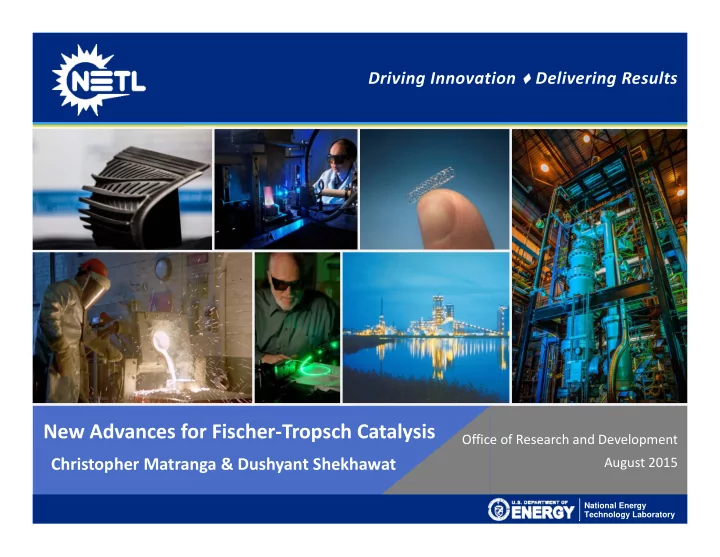

Driving Innovation ♦ Delivering Results New Advances for Fischer ‐ Tropsch Catalysis Office of Research and Development Christopher Matranga & Dushyant Shekhawat August 2015 National Energy Technology Laboratory
A Simplified View of Fischer ‐ Tropsch Mechanistic Chemistry 6 general rxn steps: (independent of model, catalysts, rxn conditions) • Adsorption/activation Chain initiation • • Chain growth • Product desorption • Chain termination • Readsorption/further rxn 3 widely considered mechanisms on Fe: • Surface carbide (shown) • Surface enol https://youtu.be/44OU4JxEK4k • CO insertion Youtube Movie Credit: I. Filot, E. Hensen, R. van Santen Institute for Complex Molecular Systems, Eindhoven University of Technology National Energy Figure from Weckhuysen Chem. Soc. Rev., 2008, 37, pgs 2758–2781 2 Technology Laboratory
A Simplified View of Fischer ‐ Tropsch Mechanistic Chemistry 6 general rxn steps: Surface Carbide Mechanism (independent of model, catalysts, rxn conditions) • Adsorption/activation Chain initiation • • Chain growth • Product desorption • Chain termination • Readsorption/further rxn 3 widely considered mechanisms on Fe: • Surface carbide (shown) • Surface enol • CO insertion National Energy Figure from Weckhuysen Chem. Soc. Rev., 2008, 37, pgs 2758–2781 3 Technology Laboratory
Anderson ‐ Shulz ‐ Flory (ASF) Product Distributions • Radical polymerization type distro • Chain termination/progation are critical/rate ‐ determining steps • Occur for fully thermalized, “equilibrium” or “steady state” conditions National Energy Figures from R. De Deugd PhD Dissertation, Technical University of Delft, 2004 4 Technology Laboratory
Are Controlled Deviations from ASF Possible? Nano ‐ structured Catalyst Materials Non ‐ equilibrium Reactors (Microwave ‐ MW) Solid = microwaves Dashed = thermal Image from Wang et. al. ChemCatChem Doi: 10.1002/cctc.201000071 Potential Benefits Potential Benefits • Non Anderson ‐ Shulz ‐ Flory Product Distributions • Non ‐ thermal & Non ‐ ASF Product Distributions • Stabilization of active catalyst phase • Lowered reactor temperatures • Controlled production of oxygenates/aromatics Improved kinetics, reactivity & conversion • • Improved reactivity & conversion National Energy 5 Technology Laboratory
Motivation from Previous Literature: Process Intensification w/Nano ‐ Catalysis Fe 2 O 3 in Carbon Nanotubes Fe & Fe ‐ carbide form at lower T Altered Product Distros For Fe 2 O 3 inside CNTs Fe 2 O 3 outside Carbon Nanotubes Legend: Black = Fe inside CNTs Red = Fe outside CNTs Blue = Fe on act. carbon National Energy Data & Images from Bao et. al. JACS, doi: 10.1021/ja8008192 6 Technology Laboratory
Recent Nano ‐ catalyst results from ORD National Energy 7 Technology Laboratory
Layered Graphene Catalyst Supports for Breaking ASF Distributions Adsorption Isotherms in Graphene Oxides Can this be exploited for FT ? Layered graphene controls surface mobility of FT ‐ type species (Li et. al., Science, 2013) • Surface mobility disrupted (kinetic effect) • More H 2 adsorbed than N 2 (size exclusion) National Energy 8 Technology Laboratory
Nanostructured Fe 5 C 2 “Häggs Phase” X ‐ ray diffraction confirms 10 nm Fe 5 C 2 20 nm Fe 5 C 2 nano ‐ Fe 5 C 2 structure • Fe 5 C 2 Häggs phase one of most active phases for FT • ORD synthesis produces high yield, gram, batches of nearly pure Fe 5 C 2 • Nanoparticle shell is a mixed amorphous Fe ‐ carbide/oxide Future work will incorporate into layered graphene and/or carbon nanotube supports • National Energy 9 Technology Laboratory
Synchrotron X ‐ ray characterization of nano ‐ Fe 5 C 2 O K edge X ‐ ray absorbance Fe L edge X ‐ ray absorbance 20 nm Fe-carbide Normalized Absorbance 10 nm Fe-carbide Normalized Absorbance 20 nm Fe-carbide 10 nm Fe-carbide Fe 3 C Fe 3 C Fe 3 O 4 Fe 3 O 4 Fe 2 O 3 Fe 2 O 3 FeO FeO Fe Fe 705 710 715 720 725 730 525 530 535 540 545 550 555 Photon Energy (eV) Photon Energy (eV) National Energy 10 Technology Laboratory
Summary • ASF arises from a radical chain polymerization process at thermal equilibrium • Deviations from ASF require disrupting molecular processes on catalyst/support surface (adsorption, diffusion, etc) • Microwave reactors offer additional opportunities to deviate from ASF • Nano ‐ structured Graphene and Fe 5 C 2 have been synthesized and initial characterization started. National Energy 11 Technology Laboratory
Recommend
More recommend